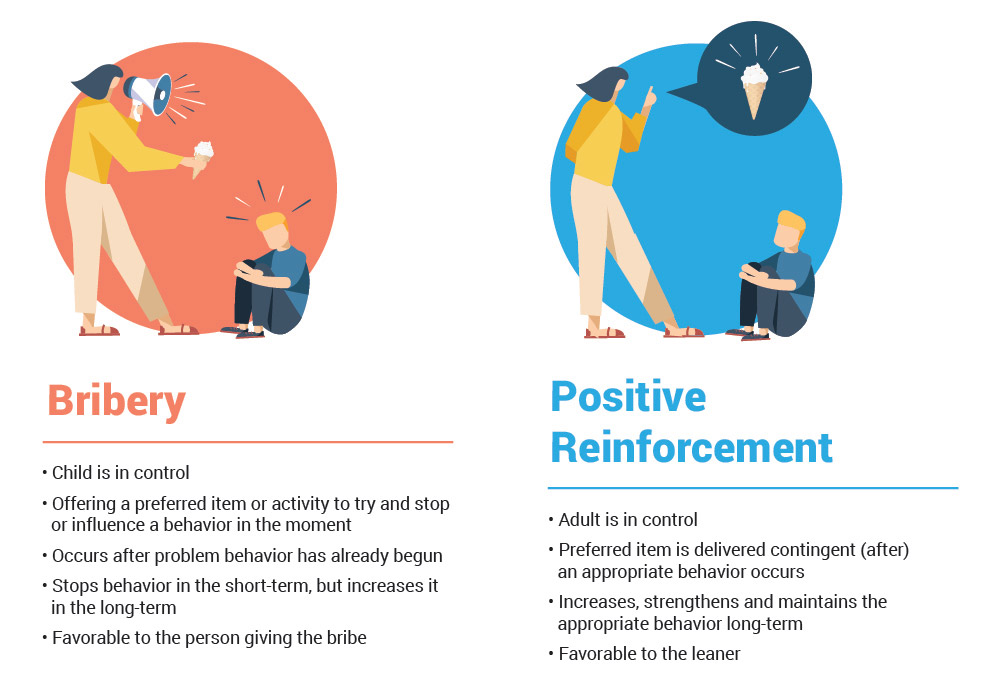Bribery Vs Positive Reinforcement – Practical, Behavioral Help for Autism
Positive reinforcement is often confused with bribery. But, is it important for parents (especially for those with children on the autism spectrum) to distinguish the difference between bribery and reinforcement. Equally important is the knowledge of HOW to practically use positive reinforcement to help everyday behaviors.
Does This Behavioral Scenario Sound Familiar?
After working all day, cleaning up after your kids, you’ve spent the past hour cooking an amazing meal for your family, and you put it in front of your toddler and tell him to take a bite. He immediately starts to cry and demand chicken nuggets. Thinking quickly, you say “Hey, I’ll make you a deal, you stop crying and I’ll go make you some chicken nuggets.” Your sigh of relief is palpable as the crying stops, and it’s quiet once more. For many parents, this is a common occurrence, and most of us don’t pause to analyze what we may be teaching at that moment.
Instead, as we take a deep breath and start to relax, we catch a glimpse of our beloved, exhausting child, no longer crying, and start making some chicken nuggets in peace, and that’s when it happens. We fall into the trap…the bribery trap.
Wait, you think, I’m not bribing my child, I’m using positive reinforcement! Plus, you think, my child is happily eating dinner, no longer screaming. What I did was the right thing, and it worked! While the tantrum may have stopped in the short-term, using bribery will only make it where there are more tantrums in the long run.
Is It Bribery or Reinforcement? Why Should I Care?
In the example above, providing the chicken nuggets after the tantrum started “fixed” the problem, so why is it important to distinguish the difference between bribery and reinforcement?
Bribery occurs after a child has already begun engaging in problem and is offered something like ice-cream or a tablet to get them to stop the problem behavior, which does not change or add skills to your learner’s repertoire. Bribery is a one-time interaction where goods or attention are exchanged in order for a change in behavior to occur. In the example above, offering to cook chicken nuggets might get him to eat dinner one night, but tomorrow night when he wants chicken nuggets again, the same “bribe” or “exchange” will need to happen again. This puts the child in control of the exchange.
Reinforcement is when a tablet, food, attention or something preferred is given after and contingent on an appropriate behavior we’re looking to change occurring. The delivery of the reinforcer only after the behavior we want to see means that we can increase an appropriate behavior, which benefits the learner. In the example above, you might have your child take a bite of the dinner you made, then they would earn a bite of chicken nuggets. By using the chicken nugget as a reinforcer, and requiring a bite of dinner, you are teaching and reinforcing an appropriate behavior that will be the go-to in the future.
Of course, we’re assuming that the function of the tantrum is access to an item or your attention, and while the difference is subtle it’s important because even though the tantrum initially stopped, more will occur long-term.
Positive reinforcement has often been confused with bribery.
A common rebuttal I hear when working with parents is, “I don’t want to bribe my kid to do what they’re supposed to do anyway.” When parents say that, it usually means that they have inadvertently been using bribery instead of reinforcement.
Initially, it may be difficult to comprehend, but here are a few things to keep in mind.
- If what you’re currently doing isn’t working, it’s time to try something new
- You wouldn’t go to work if you didn’t earn a paycheck
- These skills are your child’s work, and they do much better with a paycheck (motivator)
- If you can motivate up front and teach appropriate skills, the amount of problem behavior you have to deal with by not bribing should decrease significantly.
How Do I Set Up To Positively Reinforce Behavior?
Catch them being good: If you know you’re going to give your child (or adult) something they want like the tablet or ice cream, give it to them when they’re already doing something you want to see more of. For example, if your child is coloring nicely, or put up their toys the first time you asked, go ahead and reward that behavior with the tablet or a piece of candy.
** Note: A common error I see parents make is not reinforcing appropriate behavior when their child is doing it because “they’re doing so well; I just don’t want to interrupt them.” The more reinforcement you provide for doing what they should be doing, the more they’ll do what you want them to! **
Pick an appropriate behavior to reinforce: Pick something that you can reliably get your child to do. Start easy and work your way up to more complicated tasks. You can start with something easy like picking up one toy instead of all their toys. The easier it is, the more likely they are to do it, if you start with something that takes too long or is too difficult you are more likely to see tantrums or other problem behavior.
Watch for the warning signs: Look for signs that a tantrum or meltdown may occur, and get your child to engage in some kind of communication or being calm so you can give them access to what they want. You are more than welcome to prompt them to do or say something and reinforce that appropriate communication.
What if Problem Behavior Occurs?
Wait for something you can reinforce: It can be something as simple as waiting for them to calm down. For example, as they stop crying and calm down, provide some praise such as “I like how you’re calming down.” My rule of thumb is that when you provide praise for engaging in some kind of appropriate behavior, you can tell them one time how they can earn what they want to, or tell them when they can have what they want. For example, after you say “I like how you’re calming down, in order to get chicken nuggets, you have to first eat five bites of your dinner.”
Bribery Versus Positive Reinforcement

Would you like to learn more? Check out Mary Barbera’s podcast about Positive Reinforcement vs. Bribery. Also, the Behavior TLC Day Program focuses on acquiring new skills, maintaining existing skills and decreasing unwanted behaviors through positive reinforcement
References – Cooper, J., Heron, T., & Heward, W. (2007). Basic Concepts. Applied Behavior Analysis (2nd ed., pp 560-567). Columbus: Pearson

ASHLEY MASSEY
Title: Board Certified Behavior Analyst
Ashley is a Board Certified Behavior Analyst (BCBA) and Licensed Behavior Analyst (LBA) living in Houston Texas. She is a Colorado transplant, who earned her Bachelor ’s degree in Psychology from Baylor. She continued her education at UHCL, earning her Masters in Applied Behavior Analysis.
Ashley has over 10 years of experience working with an extremely diverse population of individuals ranging from very young toddlers to young adults. Her treatment experience involves providing services in multiple settings, such as comprehensive clinical day treatment settings, focused treatment settings, private schools, public schools, and in-home therapy. Ashley’s previous experience includes a robust skillset implementing interventions that focus on speech, verbal behavior, social skills, and parent trainings. She previously helped develop and manage a social skills program and a Medicaid-funded focused therapy program. Ashley has been working as a BCBA/LBA at Behavior TLC’s Clear Lake clinic since January of 2017.











